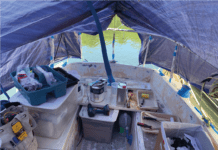The past couple of months I’ve been engaged in an ongoing struggle to remove all the deck paint and primer from Opal, the 1971 Sparkman Stephens designed Yankee 30 that I’m restoring with the help of local professionals in the St. Petersburg, FL area.
One would think that after 10 years of full-time cruising, and 21 years as a boating magazine editor, I’d have no problem choosing the tools and techniques for a seemingly straightforward task. But, as with many small projects we undertake each spring, “straightforward” jobs have a way of mushrooming into much more complicated projects.
Granted, removing paint and primer from a 30-foot boat is a big project to begin with, but not—so I thought— too complex. However, I soon found myself diving into the PS archives for help. My decision to keep the hardware in place complicated matters, but nearly all of the questions I had were answered by past reports, although a couple relevant reports, like our comprehensive sandpaper test, dated back to our black-and-white days.
Removing old paint from the flat deck areas with an orbital sander is fairly straightforward, but removing the thick halos of paint around handrails, winches, and along the T-tracks for the jib leads (see photo) proved more challenging. Ultimately, I settled on a combined approach that relied on careful use of a potent stripper — Jamestown Distributor’s Total Strip and Franmar’s Blue Bear 670AF worked best — and a variety of tools, including scrapers, sandpapers, and sanding sponges, all of which we’ve covered in past reports.
This month’s issue explores one of the most helpful tools for the project, a powerful dust-collecting vacuum system that will minimize the mess, and reduces your exposure to airborne dust. This leads me to the most important lesson of my project—be safe.
Spring is just around the corner, which means many of us will be engaged in maintenance or repair projects which pose a risk of injury, or expose us to harmful materials.
We’ve covered boatyard safety from several angles, and I’ve recently updated a previous post, “Staying Safe in the Boatyard” with some of our most recent reports. Before digging into your own repair project, I encourage you to give it a read and to check out the links. For tips on specific projects, I’ve highlighted some of our more popular maintenance reports.
If none of those reports fits your project, try the “search” function on the website, and if you are still having trouble finding a particular report, email me at [email protected], and I’ll help you find it. Oh . . . and if you have a favorite trick or tool for removing five layers of paint and primer from corners and crannies, let me know so I can include it in our upcoming report on deck and topside paint projects.











































I’ve only see the ambulance come to the boat yard twice. Both were falls from ladders.